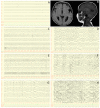Neurological Phenotype of Mowat-Wilson Syndrome
- PMID: 34199024
- PMCID: PMC8305916
- DOI: 10.3390/genes12070982
Neurological Phenotype of Mowat-Wilson Syndrome
Abstract
Mowat-Wilson Syndrome (MWS) (OMIM # 235730) is a rare disorder due to ZEB2 gene defects (heterozygous mutation or deletion). The ZEB2 gene is a widely expressed regulatory gene, extremely important for the proper prenatal development. MWS is characterized by a specific facial gestalt and multiple musculoskeletal, cardiac, gastrointestinal, and urogenital anomalies. The nervous system involvement is extensive and constitutes one of the main features in MWS, heavily affecting prognosis and life quality of affected individuals. This review aims to comprehensively organize and discuss the neurological and neurodevelopmental phenotype of MWS. First, we will describe the role of ZEB2 in the formation and development of the nervous system by reviewing the preclinical studies in this regard. ZEB2 regulates the neural crest cell differentiation and migration, as well as in the modulation of GABAergic transmission. This leads to different degrees of structural and functional impairment that have been explored and deepened by various authors over the years. Subsequently, the different neurological aspects of MWS (head and brain malformations, epilepsy, sleep disorders, and enteric and peripheral nervous system involvement, as well as developmental, cognitive, and behavioral features) will be faced one at a time and extensively examined from both a clinical and etiopathogenetic point of view, linking them to the ZEB2 related pathways.
Keywords: GABAergic transmission; ZEB2; corpus callosum; epilepsy; intellectual disability.; neural crest; neurodevelopmental delay; sleep disorders.
Conflict of interest statement
The authors declare no conflict of interest.
Figures


References
-
- Adam M.P., Conta J., Bean L.J.H. Mowat-Wilson Syndrome. In: Adam M.P., Ardinger H.H., Pagon R.A., Wallace S.E., Bean L.J.H., Mirzaa G., Amemiya A., editors. GeneReviews® [Internet] University of Washington; Seattle, WA, USA: 1993. - PubMed
-
- Yamada K., Yamada Y., Nomura N., Miura K., Wakako R., Hayakawa C., Matsumoto A., Kumagai T., Yoshimura I., Miyazaki S., et al. Nonsense and frameshift mutations in ZFHX1B, encoding Smad-interacting protein 1, cause a complex developmental disorder with a great variety of clinical features. Am. J. Hum. Genet. 2001;69:1178–1185. doi: 10.1086/324343. - DOI - PMC - PubMed
-
- Wilson M., Mowat D., Dastot-Le Moal F., Cacheux V., Kääriäinen H., Cass D., Donnai D., Clayton-Smith J., Townshend S., Curry C., et al. Further delineation of the phenotype associated with heterozygous mutations in ZFHX1B. Am. J. Med. Genet. 2003;119A:257–265. doi: 10.1002/ajmg.a.20053. - DOI - PubMed
-
- Yamada Y., Nomura N., Yamada K., Matsuo M., Suzuki Y., Sameshima K., Kimura R., Yamamoto Y., Fukushi D., Fukuhara Y., et al. The spectrum of ZEB2 mutations causing the Mowat-Wilson syndrome in Japanese populations. Am. J. Med. Genet. Part A. 2014;164:1899–1908. doi: 10.1002/ajmg.a.36551. - DOI - PubMed
Publication types
MeSH terms
Substances
Supplementary concepts
LinkOut - more resources
Full Text Sources
Research Materials

